Chinaberry Tree (Melia Azedarach): Leaves, Flowers, Bark, Fruit (Pictures) – Identification
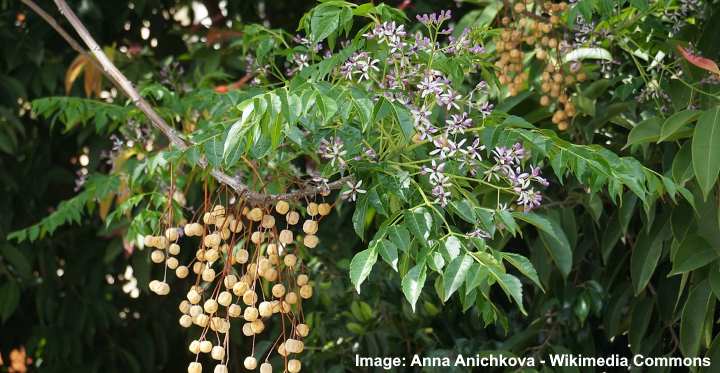
The chinaberry tree (Melia azedarach) is an ornamental deciduous tree with small, fragrant purple flowers, long compound leaves, and small yellow berries. A chinaberry tree is recognizable in the landscape by its rounded open crown, brownish-red bark, and bright yellow fall color. In some warm climates, the chinaberry tree is a beautiful shade tree for a garden landscape. However, in other places, this non-native tree is invasive and can take over the landscape.
This article is a guide to identifying a chinaberry tree. First, descriptions and pictures of this decorative tree can help to recognize the tree. Then, if you decide to grow the tree in your area, you’ll find helpful tips on growing chinaberry trees in your front or backyard.
Chinaberry Tree Facts
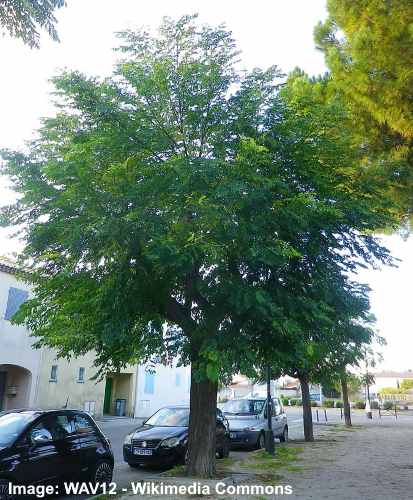
Chinaberry tree (Melia azedarach)
The chinaberry tree is a fast-growing deciduous tree native to India, Southeast Asia, and Australia. The tree is in the flowering plant genus Melia and the family Meliaceae. A mature chinaberry tree grows between 20 and 40 ft. (7 – 12 m) tall and wide. The rounded crown has slightly drooping branches, which may require pruning to increase clearance beneath the tree.
Although not native to the United States, chinaberry trees grow widely in USDA zones 7 through 10. You will see chinaberry trees growing in Florida, the Carolinas, Texas, and west to California. In addition, you can find chinaberry trees growing on the edges of woodlands, along roadsides, and open areas.
The China bead tree or chinaberry tree has an average lifespan of 20 years. However, under ideal conditions, the tree can sometimes live longer for up to 40 years.
Chinaberry trees thrive in a wide range of soils. The trees grow in full sun or partial shade and thrive in alkaline or acidic soils. Once established, the non-native tree is relatively drought-tolerant and resistant to disease.
The tree Melia azedarach has many common names describing its shape and fruit. The tree also goes by the following names: chinaberry bead tree, pride of India, China ball tree, Persian lilac, Texas umbrella tree, white cedar, or China tree.
The primary use of chinaberry trees is to provide shade and timber. The tree was imported in the 1800s and was planted extensively throughout the south as an ornamental shade trade. In addition, wood from chinaberry trees is used in furniture making and as firewood.
Chinaberry tree growth rate
A chinaberry tree has a fast growth rate. During the first two years after planting, chinaberry tree can reach around 10 feet tall (3 m). After the tree reaches 20 feet (7 m), its growth slows, and the tree eventually matures to about 40 feet tall (12 m).
Is chinaberry an invasive plant?
A chinaberry tree is considered an invasive, weed-like plant in most southern states in the US. This is because the invasive tree grows fast and adapts to a wide range of soils. And, as a non-native tree, a chinaberry doesn’t succumb to pests or diseases.
Additionally, the tree tends to sprout suckers, which can damage sidewalks and driveways. And in the spring, when the previous year’s berries drop, the fruit of the chinaberry tree can cause a significant mess.
Therefore, if you are considering planting this ornamental tree, it is a good idea to check if it’s advisable in your area.
Chinaberry Tree Leaves

Chinaberry leaves
Leaves on a chinaberry tree consist of small leaflets creating a pinnately or palmately compound leaf. Each lance-shaped leaflet has a serrated margin and pointed apex. Leaves measure up to 20” (50 cm) long with between 12 and 24 small blades on each leaf. Chinaberry leaves are green and turn golden yellow in the fall.
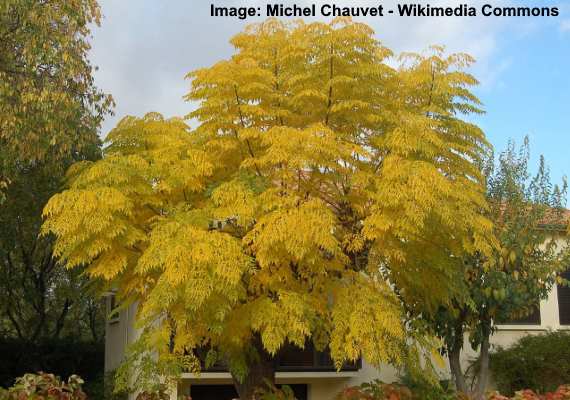
Chinaberry tree in autumn
Chinaberry Tree Bark

Chinaberry tree bark: from young tree (left) to mature tree (right)
Bark on the trunk of a chinaberry tree is dark chocolate brown to reddish-brown. Immature chinaberry trees have smooth red bark with grayish vertical lines. As the tree matures, the bark develops fissures and flaky scales.
Chinaberry wood is the tree’s most significant value. Because Melia azedarach is related to mahogany, the timber is high-quality with an attractive grain and reddish color. Although chinaberry wood is somewhat brittle, it is excellent for making furniture and other high-end wooden items.
Chinaberry Tree Flowers
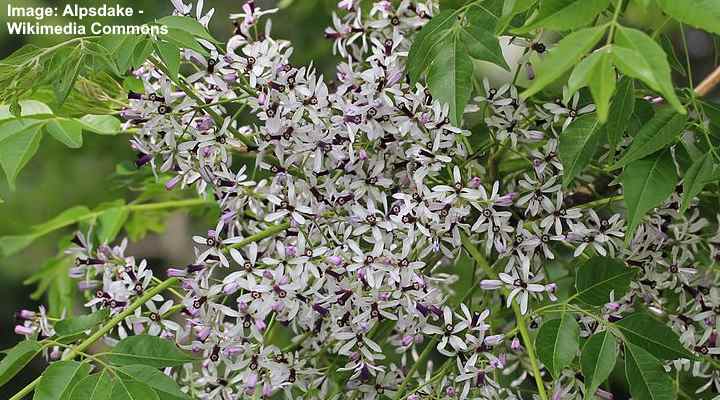
Chinaberry tree flowers
Flowers on a chinaberry tree are clusters of light-purple flowers growing in an open panicle. Individual flowers consist of five liner petals forming a whitish-purple ray. The center of the flower has a prominent dark purple tube. When in bloom, the purplish clusters of flowers with the tree’s feathery foliage create a soft, fuzzy appearance.
Chinaberry trees bloom with lilac-colored flowers from late spring through the summer. Although the dainty purplish flower clusters aren’t particularly showy, they provide some color in spring and summer landscapes.
Chinaberry Berries
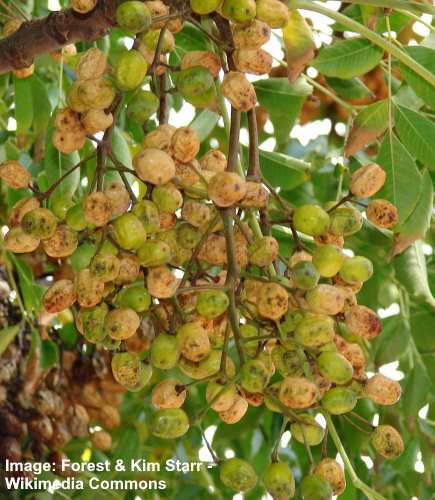
Chinaberry fruit is poisonous
The berries from the chinaberry tree are drupes—small fleshy fruits with a single hard seed. The round golden yellow or green chinaberry fruits are round and bead-like and measure up to 0.5 (1.2 cm) in diameter. The marble-like berries grow in clusters and persist on the tree through winter before dropping in spring.
Chinaberry berries contain a mucilaginous sticky substance that can cause a mess on sidewalks. However, there is also a safety issue. The slimy flesh can make pathways slippery and increase the risk of slipping. So this is a factor to consider if growing a chinaberry tree in your yard.
The bead-like seeds were used to produce rosary beads. This is a reason the chinaberry tree also has the name bead tree.
Chinaberry Tree Identification
Chinaberry tree is identified by its pinnately compound large leaves, clusters of light purple spindly flowers, and reddish-brown bark. In the landscape, you can identify the chinaberry tree by its rounded, spreading crown. In winter and the fall, you’ll notice clusters of distinctive round berries dangling from the crooked branches.
Chinaberry tree identification is crucial because this tree commonly grows in the wild. However, its fruit and leaves are poisonous.
How to Care for a Chinaberry Tree
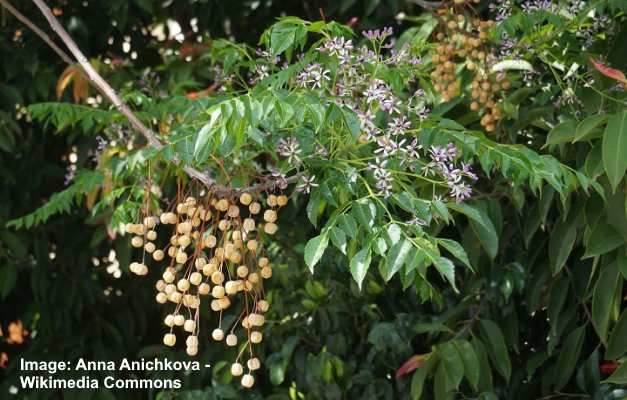
Chinaberry trees grow best in full sun and alkaline well-drained soil, however they can tolerate some shade and other types of soil
To care for a chinaberry tree, grow the plant in soil that has excellent drainage. Chinaberry trees thrive in full sun to partial shade. Water the tree regularly during the growing season to keep the ground moist. In winter, hold off watering and remove shoot suckers in spring.
Let’s look in more detail at how to grow a chinaberry tree in a landscape.
Where to Plant a Chinaberry Tree
The best location in a yard to plant a chinaberry tree is where it gets at least six hours of sunlight daily. Full sun creates the best conditions to grow this ornamental shade tree. The chinaberry tree will also grow well in part shade. However, too much shade will affect the tree’s growth.
The only consideration about where to plant a chinaberry tree is the soil drainage. Chinaberry trees grow in any type of soil—clay, loamy, sandy, acidic, or alkaline. However, the tree doesn’t perform well in soggy, waterlogged ground. Therefore, you may have to amend the soil to improve drainage if water drains slowly.
Chinaberry trees grow best in alkaline soil. The tree’s leaf litter decomposes in the ground and creates an alkaline environment. This is one of the reasons a chinaberry tree is considered an invasive plant. Most native trees thrive in acidic soil. Therefore, chinaberry trees growing nearby native trees may choke out these trees.
How to Water a Chinaberry Tree
Regular watering is essential for growing a chinaberry tree in a residential landscape. It is necessary to water the ground regularly whenever the top 2” to 3” (5 – 7.5 cm) of soil is dry. During the summer, water the tree once a week if there is no rainfall.
When watering a chinaberry tree, always water the roots deeply. These “bead” trees have a deep taproot system that requires constant moisture. Although the plant is relatively resistant to drought once mature, underwatering a chinaberry tree in the summer will result in crispy leaves, poor blooming, and few berries.
Chinaberry trees go dormant in the winter and don’t require watering. However, if the ground gets too much moisture, you might see signs of root rot, damaged pale foliage, or stunted growth.
Temperature and Humidity Requirements to Grow a Chinaberry Tree
A chinaberry tree thrives in USDA zones 7 to 10 where temperatures are between 77°F and 95°F (25°C – 35°C). However, the sun-loving, heat-loving tree goes into dormancy when average temperatures drop below 68°F (20°C). Although chinaberries can withstand some frost, the branches will die back if temperatures drop to 23°F (-5°C).
When it comes to humidity, chinaberry trees grow just as well in Florida as in drier, hot states. The ideal humidity range for chinaberry trees is between 35 and 55 percent. The fast-growing trees thrive in high humidity and grow well in drier climates if they get enough water.
Mature chinaberry trees can continue to grow during short spells of drought, even in high temperatures. Additionally, the robust, hardy tree withstands urban pollution, poor drainage, and compacted soil.
Chinaberry Tree Growth — Fertilizing
There are no specific fertilizer requirements for growing a chinaberry tree. The non-native tree can thrive in poor soil where other trees would struggle. The leaf litter from the tree adjusts the soil’s pH levels to create the ideal alkaline conditions for healthy growth.
Yellowing leaves, poor growth, and spotted foliage could be signs that the soil in your garden lacks essential nutrients—nitrogen, potassium, and phosphorus. Therefore, it may be good to get the soil tested for micronutrient deficiencies before applying fertilizer.
To encourage healthy growth, you could apply a slow-release balanced tree fertilizer every spring. For example, a fertilizer with an NPK rating of 10-10-10 can help promote healthy foliage, prolific blooming, and plenty of berries. In addition, you could apply a layer of rotted manure in the fall to boost the soil’s nutrient content.
How to Prune a Chinaberry Tree
Pruning a chinaberry tree has two goals—improve the tree’s shape and remove suckers. First, to encourage healthy growth, remove any dead or diseased branches. Next, remove any spindly or crossed-over branches to help promote the tree’s distinctive umbrella shape. This will help to develop an attractive open canopy as the tree grows.
To ensure the chinaberry tree doesn’t grow with a chaotic shape, remove secondary limbs when the tree is immature. Leaving a few healthy trunks will help the tree develop an attractive form. As part of your regular chinaberry tree care, remove all suckers or root shoots as they appear.
Chinaberry Tree Propagation
Propagating a chinaberry tree is usually done by planting seeds or taking stem cuttings. The chinaberry tree has rapid growth, and it’s easy to propagate with either method.
Propagating a chinaberry tree from seed
To grow a chinaberry tree from seed, pick the seeds from a tree after the leaves have dropped. Then remove the outer fleshy seed coating. You can then store the seeds in a dry, cool place until spring. In spring, you can plant the seeds directly in the soil.
You can also start chinaberry seeds in a moist potting mix after collecting them. They will take up to three months to germinate. It’s good to note that chinaberry trees don’t like being transplanted. Therefore, choose a large enough pot where the seedlings can grow for a year before transplanting to the garden.
Propagating a chinaberry tree from cuttings
To grow a chinaberry tree from cuttings, take a 6” (15 cm) cutting from the tip of a healthy branch. Then choose the ideal location for growing a chinaberry tree and plant the cutting directly in the ground. Put a layer of mulch around the cutting to keep the soil moist and prevent weeds. It takes four to eight weeks for cuttings to take root.
Pest and Diseases Affecting Chinaberry Tree Growth
Pests don’t affect chinaberry trees. Botanists say that there are no natural insects, bugs, or mites that affect the tree’s growth. In fact, most people consider the tree a pest due to its weedy growth and invasive characteristics.
In its native region of southeast Asia, the most common pest to affect chinaberry trees is the white cedar moth caterpillar (Leptocneria reducta). This brown spiny caterpillar can quickly defoliate a chinaberry tree and cause considerable damage.

White cedar moth caterpillar (Leptocneria reducta)
Poor growing conditions can cause fungal or bacterial diseases to infect a chinaberry tree. For example, soggy soil can cause the roots to rot and allow fungal infections to infect the tree’s roots. Symptoms of root rot include drooping leaves that turn yellow and poor plant growth.
Additionally, mineral or nutrient imbalances in the soil can affect the tree’s growth. For example, too little nitrogen can cause yellowing leaves and slow growth. Likewise, a phosphorus deficiency causes leaf spot, and a lack of potassium can result in yellow leaves with brown tips.
Chinaberry Tree Control
Due to its aggressive growth, the chinaberry tree is considered an invasive tree. According to the University of Florida, the chinaberry tree should be managed in the landscape to prevent escape. However, eradicating the tree from a landscape can be challenging. Most experts recommend a treatment using herbicides to treat the stump or branches after cutting the tree.
Is Chinaberry Tree Toxic?
The fruit, bark, flower, sap, and leaves from a chinaberry tree contain toxins that are poisonous to humans and mammals. According to the Australian Government, it can take as little as six to eight fruits to have a fatal effect on a person. Signs of toxic poisoning from a chinaberry tree include gastrointestinal upset, diarrhea, vomiting, and even cardiac arrest.
Related articles:
